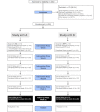Comparing the Effectiveness, Tolerability, and Acceptability of Heated Tobacco Products and Refillable Electronic Cigarettes for Cigarette Substitution (CEASEFIRE): Randomized Controlled Trial
- PMID: 37014673
- PMCID: PMC10131829
- DOI: 10.2196/42628
Comparing the Effectiveness, Tolerability, and Acceptability of Heated Tobacco Products and Refillable Electronic Cigarettes for Cigarette Substitution (CEASEFIRE): Randomized Controlled Trial
Abstract
Background: People who smoke and who face challenges trying to quit or wish to continue to smoke may benefit by switching from traditional cigarettes to noncombustible nicotine delivery alternatives, such as heated tobacco products (HTPs) and electronic cigarettes (ECs). HTPs and ECs are being increasingly used to quit smoking, but there are limited data about their effectiveness.
Objective: We conducted the first randomized controlled trial comparing quit rates between HTPs and ECs among people who smoke and do not intend to quit.
Methods: We conducted a 12-week randomized noninferiority switching trial to compare effectiveness, tolerability, and product satisfaction between HTPs (IQOS 2.4 Plus) and refillable ECs (JustFog Q16) among people who do not intend to quit. The cessation intervention included motivational counseling. The primary endpoint of the study was the carbon monoxide-confirmed continuous abstinence rate from week 4 to week 12 (CAR weeks 4-12). The secondary endpoints included the continuous self-reported ≥50% reduction in cigarette consumption rate (continuous reduction rate) from week 4 to week 12 (CRR weeks 4-12) and 7-day point prevalence of smoking abstinence.
Results: A total of 211 participants completed the study. High quit rates (CAR weeks 4-12) of 39.1% (43/110) and 30.8% (33/107) were observed for IQOS-HTP and JustFog-EC, respectively. The between-group difference for the CAR weeks 4-12 was not significant (P=.20). The CRR weeks 4-12 values for IQOS-HTP and JustFog-EC were 46.4% (51/110) and 39.3% (42/107), respectively, and the between-group difference was not significant (P=.24). At week 12, the 7-day point prevalence of smoking abstinence values for IQOS-HTP and JustFog-EC were 54.5% (60/110) and 41.1% (44/107), respectively. The most frequent adverse events were cough and reduced physical fitness. Both study products elicited a moderately pleasant user experience, and the between-group difference was not significant. A clinically relevant improvement in exercise tolerance was observed after switching to the combustion-free products under investigation. Risk perception for conventional cigarettes was consistently higher than that for the combustion-free study products under investigation.
Conclusions: Switching to HTPs elicited a marked reduction in cigarette consumption among people who smoke and do not intend to quit, which was comparable to refillable ECs. User experience and risk perception were similar between the HTPs and ECs under investigation. HTPs may be a useful addition to the arsenal of reduced-risk alternatives for tobacco cigarettes and may contribute to smoking cessation. However, longer follow-up studies are required to confirm significant and prolonged abstinence from smoking and to determine whether our results can be generalized outside smoking cessation services offering high levels of support.
Trial registration: ClinicalTrials.gov NCT03569748; https://clinicaltrials.gov/ct2/show/NCT03569748.
Keywords: e-cigarette; electronic cigarettes; harm reduction; heat not burn; psychological well-being; public health; smoking cessation; smoking reduction.
©Pasquale Caponnetto, Davide Campagna, Marilena Maglia, Francesca Benfatto, Rosalia Emma, Massimo Caruso, Grazia Caci, Barbara Busà, Alfio Pennisi, Maurizio Ceracchi, Marcello Migliore, Maria Signorelli. Originally published in JMIR Public Health and Surveillance (https://publichealth.jmir.org), 04.04.2023.
Conflict of interest statement
Conflicts of Interest: PC, DC, MS, M Migliore, and M Caruso are full-time employees of the University of Catania, Italy. RE is a fixed-term researcher at BIOMETEC, University of Catania, Italy. M Maglia and FB are fixed-term researchers at Centro per la Prevenzione e Cura del Tabagismo, University of Catania, Italy. BB is a full-time employee of ARNAS Garibaldi, Catania, Italy. AP is a full-time employee of Casa di Cura Musumeci-Gecas, Gravina di Catania, Italy. GC is a full-time employee of the Unit of Infectious Diseases, Department of Clinical and Experimental Medicine, University of Messina, Italy. M Ceracchi is an employee at FullCRO, Roma, Italy.
Figures




References
-
- Tobacco. World Health Organization. [2023-03-12]. https://www.who.int/news-room/fact-sheets/detail/tobacco .
-
- WHO report on the global tobacco epidemic, 2011: warning about the dangers of tobacco. World Health Organization. [2023-03-12]. https://apps.who.int/iris/handle/10665/44616 .
-
- National Center for Chronic Disease Prevention and Health Promotion (US) Office on Smoking and Health . The Health Consequences of Smoking—50 Years of Progress A Report of the Surgeon General. Atlanta, GA: Centers for Disease Control and Prevention (US); 2014. - PubMed
-
- US Dept of Health and Human Services . The Health Benefits of Smoking Cessation: A Report of the Surgeon General. Rockville, MD: US Department of Health and Human Services, Public Health Service, Centers for Disease Control, Center for Chronic Disease Prevention and Health Promotion, Office on Smoking and Health; 1990.
-
- Doll R, Peto R, Boreham J, Sutherland I. Mortality in relation to smoking: 50 years' observations on male British doctors. BMJ. 2004 Jun 22;328(7455):1519. doi: 10.1136/bmj.38142.554479.ae. - DOI - PMC - PubMed
Publication types
MeSH terms
Substances
Associated data
LinkOut - more resources
Full Text Sources
Medical

